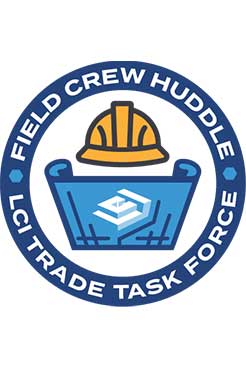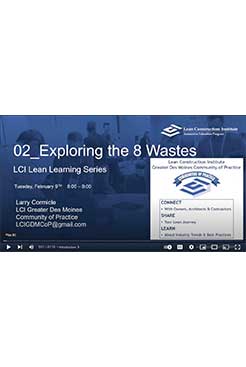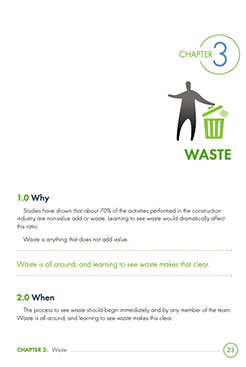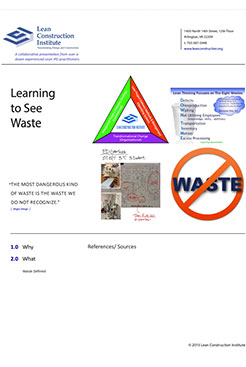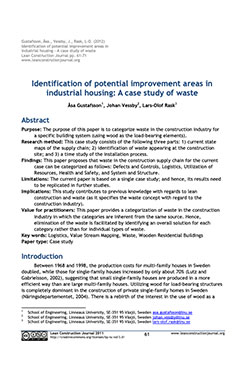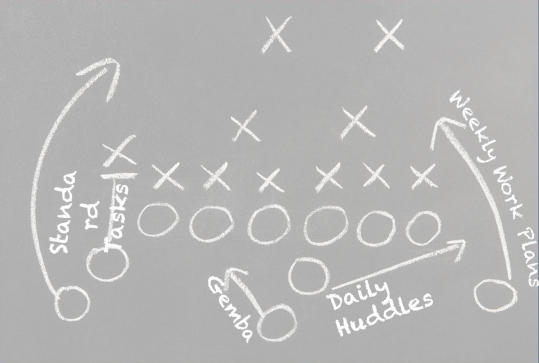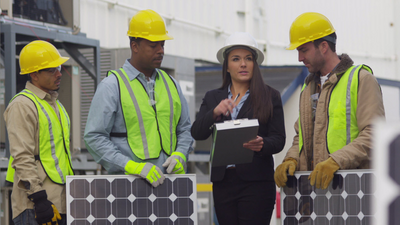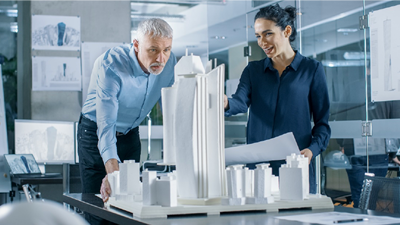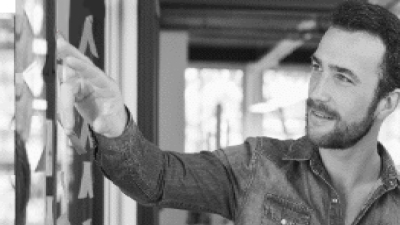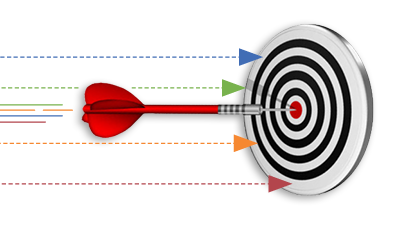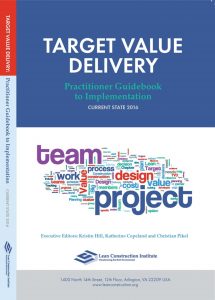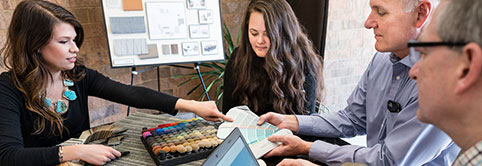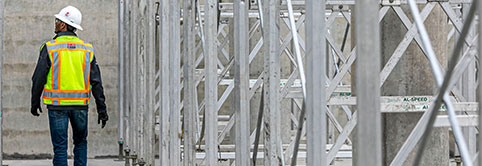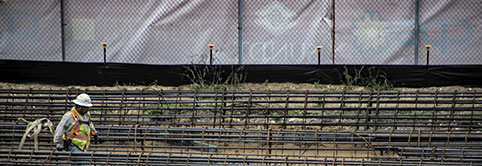8 Wastes of Lean
An Introduction to Waste
The goal of any design and construction project is ultimately to generate the most value for the customer or stakeholder. The goal of Lean is to generate that value as efficiently and as safely as possible by following the six tenets of the Lean Construction Institute, which include:
- Respect for People
- Generate Value
- Eliminate Waste
- Focus On Flow
- Continuous Improvement
- Optimize the Whole
For our purposes, we’re going to focus on eliminating waste.
What Are the 8 Wastes?
The Lean Construction Institute has identified eight different kinds of waste that occur during projects:
Over/Under Production, Waiting, Unnecessary Transportation, Over/Under Processing, Excess Inventory, Unnecessary Motion, Defects, and Unused Creativity of Team Members.
Overview: 8 Types of Waste
In the world of Lean, waste is defined as anything that doesn’t directly create value; waste can be thought of as the antithesis to value. Waste occurs during both the design and construction phases of a project. It is just as important to reduce waste in the design phase as it is during the construction phase. Let’s explore the eight different types of waste you might encounter during your projects.
1. Over/Under Production
Over and under production can be defined as making something before it is truly needed. In other words: not producing the right work at the right time in the right amount as needed by the downstream work.
Perhaps you received more materials than you asked for, received them before or after you requested them, or both. This would go against the Lean virtues of pull planning (obtaining materials only as you need them and only taking as much as you need for production).
This leads to inventory waste because you are either not receiving materials you need and are then forced to wait (in the case of underproduction) or you receive too many materials that you now have no use for (overproduction). These can both lead to expanded costs during your project and wasted time.
For more on Over/Under Production Waste explore the Field Crew Huddle Youtube Channel.
2. Waiting
The waste of waiting occurs when work-in-progress or people are waiting on the next step in production. Waiting is an extremely common type of waste that can occur in many different ways across design and construction projects.
If there’s an issue in the project that is preventing you from progressing but you’ve decided to wait until the weekly team meeting the next day to address it, that’s a type of waste. If a worker is waiting to use a piece of equipment that they cannot complete their task without, that’s a type of waste.
Daily huddles are an excellent tool for eliminating waiting waste, since they allow people the daily opportunity to address issues with the team. More efficient processes can eliminate waiting waste. It’s important to practice identifying waste causes in the production process.
3. Unnecessary Transportation
Unnecessary transportation waste includes creating inefficient transport, moving raw materials, parts, equipment, or information into or out of storage or between processes. Unnecessary transportation occurs when pull planning is poor or when there isn’t a plan for the storage of materials for safekeeping until they are needed.
Proper pull planning in a Lean manufacturing process eliminates unnecessary transportation waste since materials, equipment, and the like are only moved as they are needed for the next stage of the process.
Poor logistics in material transportation can even lead to another type of waste – defects – as materials that are moved constantly are at greater risk of being damaged.
4. Over/Under Processing
Over processing is the act of taking unnecessary steps in a process. Naturally, under processing would be neglecting to take necessary steps in a process. This was one of the most prominent types of waste that Toyota eliminated when it created the Toyota Production System, slimming down the manufacturing process to include only the necessary steps – or the steps that directly produced value.
One of the most common examples of over processing takes place during traditional Request for Information (RFI) processes, in which information is passed through several people before a question finally gets answered.
5. Excess Inventory
Excess inventory waste occurs when product, materials, work-in-progress or information quantities go beyond supporting the immediate need. Anything that is a buffer could be explored as waste. This is because most buffer is never used. The inclusion of buffer in itself goes against the notion of pull planning since it represents materials provided that were never requested.
In general, excess inventory can lead to unnecessary transportation as workers are forced to find space for materials that are not yet needed. It can also lead to unnecessary motion if workers are taking time to sift through all of the inventory to find the materials they need at the moment.
6. Unnecessary Motion
Unnecessary or excessive motion can be described as unnecessary movement by people or movement that does not add value. As mentioned above, unnecessary motion also occurs if workers are spending time searching for materials or information. Unnecessary transportation can also be a type of unnecessary motion.
More specifically, unnecessary motion often occurs on job sites when workers are constantly shuttling back and forth across the room to grab materials situated away from their work station. Unnecessary motion can also happen if excess inventory is serving as a physical roadblock in a room and a worker needs to take time to move around it.
7. Defects
Defects occur when there is a production of defective parts, work or information that causes the work to be scrapped or redone. This leads to rework, one of the biggest causes of waste and a practice that commonly leads to projects being delivered late and over-budget.
If a designer receives new information that requires them to start their design over from scratch, that’s a defect. If a worker on the construction site puts up drywall incorrectly and needs to redo the entire section, that’s a defect. Miscommunication can also lead to defects if a team realizes they didn’t properly convey the strategy to those who were tasked with executing the job.
8. Unused Creativity of Team Members
Unused creativity of team members occurs when a team loses time, ideas, skills, improvements and learning opportunities by not engaging or listening to employees. Collaboration is a huge facet to adopting Lean, and Respect for People is the most important tenet of the Lean Construction Institute around which the other five revolve. If input isn’t respected through poorly utilized talent, creative solutions to complex problems are unable to present themselves.
Waste Walk
Conducting a waste walk – or gemba walk – is an effective way to discover waste happening in production processes. During a gemba walk, one sees the process occurring in real time. Gemba walks also include asking questions of those in charge of executing those processes to find out where the value is being added and where it isn’t.
Learn More About 8 Wastes
The Lean Construction Institute is committed to transforming the design and construction industry by providing Lean educational resources, conducting field research, and facilitating local and national Lean events. Explore supplementary resources below to further your understanding of the 8 wastes and how to mitigate them.
More Lean Topics
From 5s to IPD, explore popular Lean design and construction topics below.


